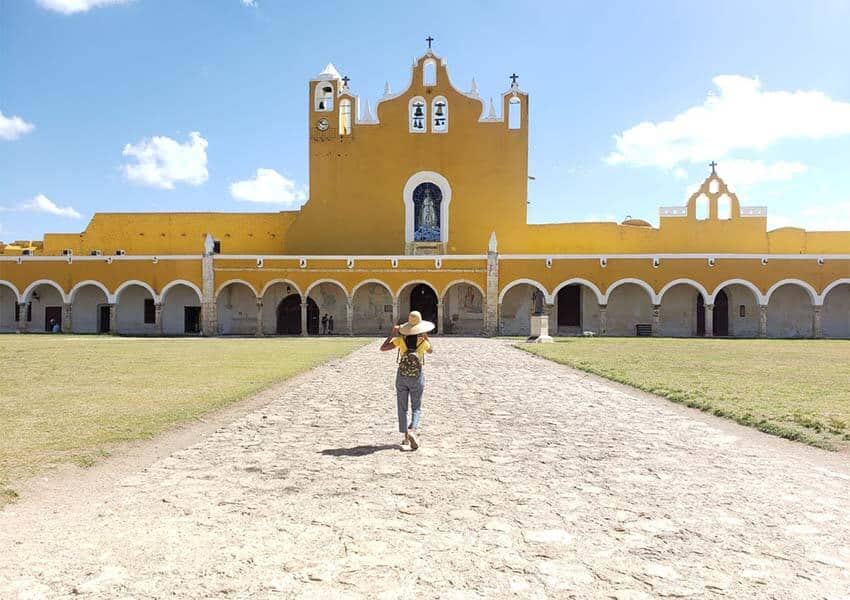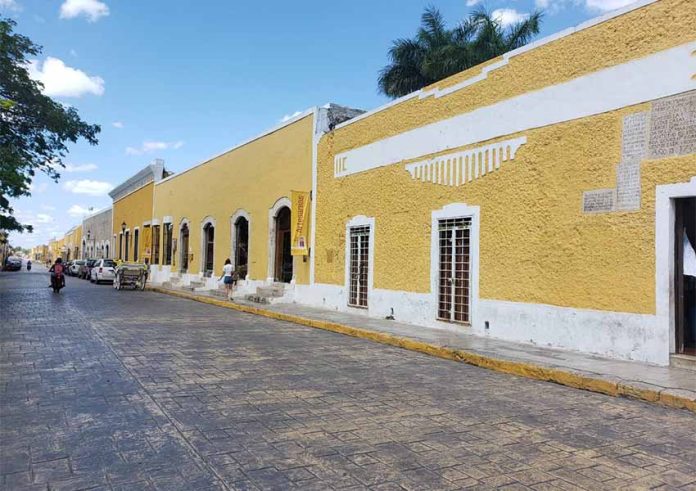Looking for an ideal day trip for your friends visiting Mexico who are keen on exploring pre-Hispanic and colonial sites? The small town of Izamal in Yucatán is a great choice.
Categorized as one of Mexico’s magical towns, Izamal has been a pilgrimage site since before the conquest. Situated around 70 kilometers from Mérida, off the Mérida-Cancún highway, it’s often known as The Yellow City.
This history of the town’s yellow-painted walls with white touches is unclear. Different theories exist: one says they were painted yellow to represent a Maya sun god, while another claims they were painted ahead of Pope John Paul II’s visit to Izamal in 1993.
One of Izamal’s nicknames is The City of Three Cultures – alluding to its mix of pre-Hispanic, colonial, and present-day characteristics. It’s also referred to as the City of Hills – which refers to its overgrown pyramids that the Spanish colonizers thought resembled hills.
Izamal is named after its founder, who according to UNESCO was a priest called Zamná, associated with the Maya creator god Itzamná.

Izamal is believed to be one of the Yucatán peninsula’s earliest Maya cities. According to the National Institute of Anthropology and History (INAH), the city was first occupied around 2,700 years ago, and its significant constructions took place in the early and late Classic period (A.D. 250–900).
Ancient Izamal had a large network of Maya white roads. One notable road is the one that connects to the Maya site Aké, situated to the west.
According to INAH, Izamal was a place of worship since it was considered Itzamná’s place, and since Zamná was believed to be buried there. It remained a key place of worship for the ancient Mayas even after it was mostly abandoned in the Postclassic period, which was likely the reason for the colonizers to settle there. The town remains a pilgrimage site to this day, especially for those of the Catholic faith.
There are several pre-Hispanic structures to explore in Izamal, in addition to the beautiful town and its colonial buildings. The ancient Maya structures are spread out, so prepare for extensive walking.
North of the main plaza is a large pyramid called Kinich Kak Moo, which means “fire macaw with solar face.” The ancient Maya believed that the sun deity to whom the Kinich Kak Moo pyramid was dedicated descended daily as a fire macaw to collect its offerings.
With a massive base measuring 200 by 180 meters and its upper pyramid reaching over 34 meters in height, it is the third-largest pyramid in Mexico. It is built over a cave that is considered a holy place. The pyramid once had stucco decoration, but no signs of it exist today.

The base has several stairways. The present-day entrance is from the south.
The upper temple of Kinich Kak Moo offers breathtaking views from its peak, allowing you to imagine the great ancient Maya city that Izamal once was. Climbing this pyramid is allowed, but the stairs are not in good condition, so climb with care.
South of the plaza, you’ll find the widely photographed St. Anthony of Padua monastery. Painted in yellow and white, it was built in the 16th century by Franciscan monks on what was once a pyramid called Paap Hol Chak.
The famous priest Diego de Landa supervised the beginning of its construction, and the project architect was also a priest – Juan de Mérida.
There are three ramps to access the monastery, with the main entrance on the west side. It features a beautiful rectangular atrium with four chapels. After the one in the Vatican’s St. Peter’s Square, this site is considered to have the world’s second largest indoor atrium, and the largest in the Americas.
A notable feature of the monastery is a gold-plated altarpiece with religious scenes. On this altarpiece is the sculpture of the Virgin of Izamal, which de Landa had brought from Guatemala.
The priest had brought two identical sculptures of the Virgin – one of which was kept in Izamal and the other in Mérida. However, the statue in Izamal was destroyed by a fire in the early 19th century, so the one in Mérida was later moved here.
What else can you check out in this beautiful town? The mural paintings in the monastery, believed to have been the artwork of the Spanish, are worth seeing. Also, make time to take a walk in nearby Itzamná park and its widely photographed landmark sign welcoming visitors to Izamal.
East of the main plaza is Izamal’s second-largest pyramid, Itzamatul. Multiple building phases can be identified here. INAH says this pyramid was dedicated to Itzamná. On our recent visit, this pyramid was closed to visitors.
West of the main plaza is another temple called Kabul. When the explorers Frederick Catherwood and John Lloyd Stephens visited Izamal in the 1840s, Catherwood – an artist and architect – drew the image of the large stucco mask of the sun god, Kinich Ahau, that was on this building but no longer exists. South of the plaza is a structure called Habuk that is also worth seeing.
There are other pre-Hispanic structures to see in Izamal, in addition to exploring the yellow city. Also, the crafts museum in town is particularly interesting. And don’t forget to indulge in some local food.
Thilini Wijesinhe, a financial professional turned writer and entrepreneur, moved to Mexico in 2019 from Australia. She writes from Mérida, Yucatán. Her website can be found at https://momentsing.com/
